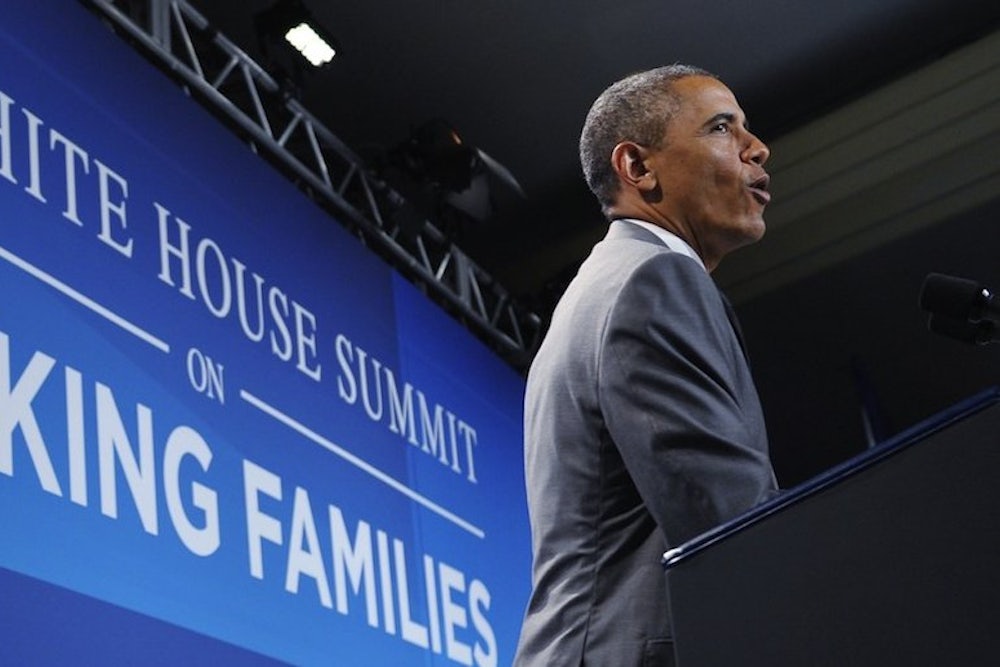The political conversation turned to work-family policy last week, thanks to a summit on “working families” that the White House co-sponsored with the Center for American Progress. One topic that got a lot of attention was paid family leave. The U.S. is the only country in the developed world that doesn’t guarantee workers time off, with at least some pay, in order to take care of a newborn or other relative who needs care. To many Americans, the idea probably seems hopelessly foreign—the kind of thing they do in the worker paradises of Sweden or Denmark or France, but not here in the U.S.
That conception is wrong. The federal government hasn’t passed a law guaranteeing paid leave, but a handful of states have. The first was California, in 2002. It didn’t happen without a fight and, at the time, business lobbies and conservatives predicted that mandating paid leave would be a disaster—crippling firms, slowing down the economy, and so on. So far, that hasn’t happened. On the contrary, the early results are encouraging, except for one glaring problem. Lots of Californians still don’t know the law exists.
Offering leave helps achieve several goals. First, and most obviously, it enables workers to take care of family members who need it—whether it’s a new baby or an elder or somebody fighting a serious disease. But leave can also help in other ways. Women still do a disproportionate share of caregiving in our society, although men are catching up. Making it possible for caregivers to take time off, without losing a job, can make it easier for women to stay in the workforce. Children benefit from leave too, too. As Jane Waldfogel, professor at the Columbia University School of Social Work, has shown, helping more parents to stay at home with newborns reduces infant mortality and increases breastfeeding among new mothers. (Research has shown that breastfeeding has short- and long-term health benefits.)
The Family Medical Leave Act, which President Bill Clinton signed in 1993, requires that employers with more than 50 employees offer workers 12 weeks of “protected” leave. But it doesn’t provide those workers with income—and that’s a big deal. It’s obviously a lot harder to take a leave if it means giving up income for that period of time. It’s particularly tough on lower-income workers, who are much more likely to live paycheck to paycheck. Companies like Deloitte and Silicon Valleys firms Google, Facebook, and Yahoo offer paid leave anyway, on their own. But they are among the minority. According to a recent report from the Bureau of Labor Statistics, just 13 percent of full-time workers have access to paid leave.
California’s law provides for six weeks of paid leave to care for a seriously ill child, spouse or direct family member or to bond with a new child. The law provides for up to 55 percent of an employee’s earnings and operates like other government social insurance funds. Employees pay into the fund, through payroll taxes. That’s still a lot less than what most European nations offer new parents. But securing just six weeks of paid leave was hard enough. The California Labor Federation, the state’s AFL-CIO, was the bill’s primary backer. The California Chamber of Commerce was its chief opponent. Along with other business-aligned and conservatives advocates, the Chamber argued that the law would add additional burden to businesses and make California uncompetitive.
Ten years to the day after the law took effect, there is no evidence that the law has hurt the economy. And if businesses think paid leave imposes a huge burden, they aren’t showing it. In a survey of businesses, conducted by the Center for Economic Policy and Research, 89 percent of businesses said they felt the California’s paid leave law had either a positive effect or no noticeable effect. (Small businesses, interestingly, were even less likely than large businesses to say the law was hurting them.) As Eileen Applebaum and Ruth Milkman, the two researchers who led the study, wrote later, “Fears expressed by opponents of the program that PFL would create a heavy burden on the state’s employers have not materialized, and some employers even report reductions in costs and improvements in productivity or profitability.” One reason it worked out this way: Studies have shown that offering paid leave tends to improve retention, particularly among women who are having children. That can be a real help for companies, given the frequently high cost of recruiting, hiring, and then training replacements.
The paid leave law also appears to have made a difference in the lives of those workers who need the help—lower-income workers who, previously, didn’t have access to the kind of generous policies that better-paid workers frequently do. According to one study, co-written by Waldfogel and published by the National Bureau of Economic Research, use of paid leave grew by anywhere from 115 to 140 percent after the law took effect. The increases were particularly pronounced among non-educated mothers (300 percent), unmarried mothers (500 percent), and African-American mothers (700 percent). “By implementing a paid law, California benefited the most women who were taking the leave, Sort of equalizing the amount of leave taken across these different groups,” says Maya Rossin-Slater, an associate professor at the University of California at Santa Barbara who has done extensive research on California’s program.
But the law could be having an even larger impact because, according to a study published in the Journal of the American Medical Association, many of the people eligible for paid leave don’t realize they are entitled to it. “Most people who were eligible didn't know they were eligible,” said Mark Schuster, one of the article’s co-authors. One reason, he said, was that California didn’t actually invest heavily in advertising and promotion. “I think that it's important to get the word out about it. One is to have a marketing campaign and with social media much stronger than in 2004.”
